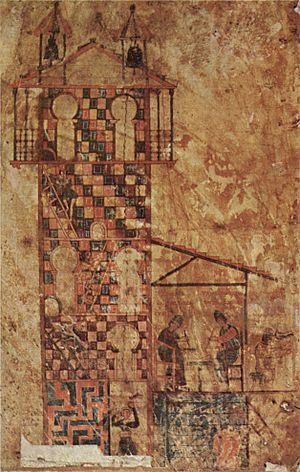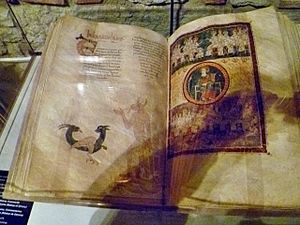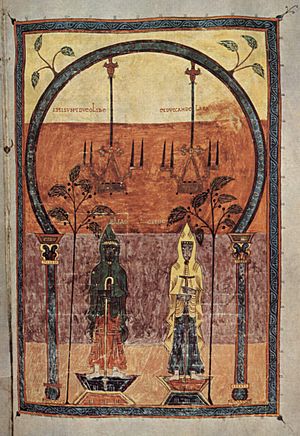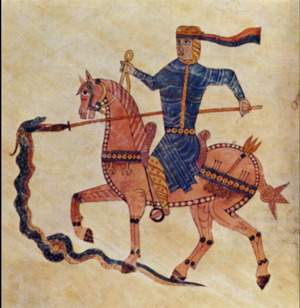Gerona Beatus facts for kids
The Gerona Beatus is a very old and beautiful book from the 10th century. It is an illuminated manuscript, which means it's a handwritten book with lots of colorful pictures. You can find it today in the museum of the Girona Cathedral in Catalonia, Spain.
This special book actually holds two different texts. One is the "Commentary on the Apocalypse" by Beatus of Liébana. This was a very popular book in medieval Spain. The other text is Jerome's commentary on the Book of Daniel. The Gerona Beatus has 284 pages, called folios, each about 400 mm by 260 mm in size. It's filled with 184 amazing miniature pictures. People say it's one of the most richly decorated and well-documented Beatus books ever made.
How the Gerona Beatus Was Made
We know a lot about how this book was created because of notes written at the end of the text. An important church leader named Abbot Dominicus asked for the book to be made. It was finished on July 6, 975. Most likely, it was created at a monastery in a place called Tábara.
The person who wrote the text was a Presbyter named Senior. What's really cool is that the names of the two artists who drew the pictures are also included! They were 'Ende, woman painter and servant of God' and 'Emeterius, monk and presbyter'. It was quite rare for artists to be named in books from this time.
The Art Style of the Book
The Gerona Beatus has a very unique and striking art style. The pictures are full of fancy decorations and tend to look flat, not 3D. The artists used a special way to draw real things, making them look almost dream-like. The colors are very bright and shiny.
Many other Beatus manuscripts from the Mozarabic period (Christians living under Islamic rule) share these artistic qualities. You can even see some Islamic art styles in the details, like the clothes worn by a horseman or the bridle of a horse.
What the Symbols Mean

The pictures and symbols in the Gerona Beatus have been discussed a lot by experts. One of the most interesting images shows a person on horseback, dressed in Islamic clothing, spearing a snake.
The meaning of this rider is part of a bigger discussion that started in the 1990s. People are still trying to figure out why Beatus wrote his commentaries and why they were so popular among Christians in Spain for many centuries. Some think these books were made to show disagreement with Islamic rule at the time.
See also
 In Spanish: Beato de Gerona para niños
In Spanish: Beato de Gerona para niños




